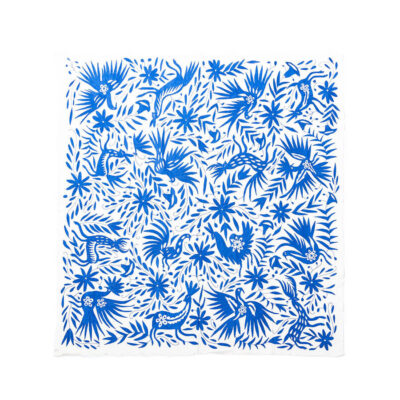Tenangos
Otomi Embroidery or Tenangos
When we talk about Mexican embroidery, embroidered Tenangos come to mind. The fame of the Tenangos has crossed borders, becoming nowadays an icon of fashion and decoration. Such is their fame that embroidered tenangos have become the most famous Mexican handicrafts. Such is their fame that they are now copyrighted.
History of Otomi embroidery or tenangos embroidery
The embroidered tenangos are also known as Otomi embroidery, as this indigenous people were the initiators of this type of handicraft. This is a type of embroidery that uses the shadow stitch technique. This type of embroidery means that the back of the embroidery only shows the colourful edges of the embroidery, while the front of the embroidery is shown in all its splendour.
Otomí embroidery began in the mid-20th century as a result of a bad harvest that left a large part of the population of Tenango de Doria in a situation of famine. As an alternative to agriculture and as a means of subsistence, the community of San Nicolás began to embroider figures representative of their flora and fauna, resulting in an explosion of colours. These embroideries are very popular and more and more embroiderers are designing their own Tenangos. It is also said that these figures are inspired by cave paintings in the San Nicolás area.
Tenangos embroidery today
Nowadays the demand is such that the prices of the embroidered tenangos are very high. The work is divided between the draftswoman and the embroiderers. The draughtswoman paints on the linen or cotton canvas (called “manta”) freehand beings that come to her mind. Subsequently, the embroiderer imprints her soul on the canvas through her choice of colours and her technique.
Traditional Tenangos embroidery continues to be an additional source of family income. Embroiderers use the time they do not spend on other tasks to embroider Tenangos. They usually spend an average of 2 to 3 hours a day on this occupation, which takes 6 to 8 months to embroider a 2×2 metre Tenango. Once the embroiderers finish their work, they sell the embroidered tenangos on market days.
We had the opportunity to go to San Nicolás and get to know first hand the wonderful history of the tenangos, as well as to offer you these marvellous artisan treasures.
How are embroidered tenangos made?
The process of making a tenango is long and laborious. It all starts with a canvas, usually beige (the natural cotton color, unbleached), which in the area is called a “manta”. On this blanket, artisans specialised in drawing tenangos draw freehand with pens or felt-tip pens the designs that will later be embroidered by the craftswomen.
There are very few artisans who draw tenangos, so it is very common for the embroiderers to buy the blanket with the tenango designs already made. The blanket is usually 2×2 metres in size. However, when the hems are hemmed and the tenangos are embroidered, this size usually decreases to approximately 1,90 metres on each side. As the designs are handmade, each tenango is unique; no two are alike, even if they have a common style of design.
The craftswomen embroiderers, once they have the blanket drawn, choose the threads for the embroidery. They normally use different coloured threads for the embroidery, creating the typical multicoloured embroidered tenangos. However, as they are large pieces, such an explosion of colour is difficult to combine in most of the homes that will be the destination of these fantastic embroideries. For this reason, embroiderers often choose to make embroidered tenangos in a single colour.
The embroiderers who do this work usually have embroidery as a second job. In this way, embroidery contributes to the family economy as an extra family income. Thus, the embroiderers, once they have done their daily chores, start embroidering. They usually do the embroidery in the afternoon, while there is still enough light to embroider. In some isolated mountain villages there is hardly any electricity, and sometimes they use candles to continue embroidering after the sun has set. This is why many women embroiderers have vision problems at a relatively young age.
The embroiderers use wooden frames for embroidery. This gives the blanket enough tension to make embroidery easier. As mentioned above, the embroidery technique used is shadow stitch. With this technique, the embroidered thread only appears on the front part of the embroidered tenango, leaving the back part only embroidered by the silhouette of the tenangos.
Where to buy embroidered Tenangos?
If you want to buy embroidered tenangos online, we have a wide catalogue in our online shop. The embroidered tenangos we offer here are the well-known 2×2 metres and you can choose from a wide range of colours. However, the size of the blanket is usually slightly smaller. This is because the blanket shrinks slightly due to the embroidery. Also the overall size is slightly reduced because the edges of the tapestry are finished off.
The embroidered tenangos can be used as a colourful bedspread. Also due to its quality and colourfulness it is increasingly used as wall decoration. As you can see, each Tenengo is a unique piece. We offer you a wide variety of colours, choose yours before they are sold out!


